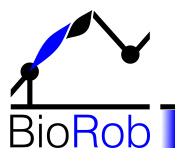Publications
2006
S. Klug, O. von Stryk, B. Möhl
Design and Control Mechanisms for a 3 DOF Bionic Manipulator
In: Proc. 1st IEEE / RAS-EMBS Intl. Conf. on Biomedical Robotics and Biomechatronics (BioRob), No. 210, February 20-22, 2006
Abstract
Functionality and design of a bionic robot arm consisting of three joints driven by elastic and compliant actuators derived from biologically inspired principles are presented. In the first design standard springs with linear characteristics are utilized in combination with electrical drives. Different control approaches for the bionic robot arm are presented, discussed and evaluation in numerical simulations and experiments with regards to the long-term goal of a natural-like control perfomance.
Functionality and design of a bionic robot arm consisting of three joints driven by elastic and compliant actuators derived from biologically inspired principles are presented. In the first design standard springs with linear characteristics are utilized in combination with electrical drives. Different control approaches for the bionic robot arm are presented, discussed and evaluation in numerical simulations and experiments with regards to the long-term goal of a natural-like control perfomance.
@INPROCEEDINGS{2006BioRob:KlugvonStrykMoehl,
author = {S. Klug and O. von Stryk and B. Möhl},
title = {Design and Control Mechanisms for a 3 DOF Bionic Manipulator},
year = {2006},
number = {210},
month = {February 20-22},
address = {Pisa, Italy},
booktitle = {Proc. 1st IEEE / RAS-EMBS Intl. Conf. on Biomedical Robotics and Biomechatronics (BioRob)},
url = {http://www.biorob.de},
pdf = {2006-BioRob-Klug-vonStryk-Moehl.pdf},
abstract = {Functionality and design of a bionic robot arm consisting of three joints driven by elastic and compliant actuators derived from biologically inspired principles are presented. In the first design standard springs with linear characteristics are utilized in combination with electrical drives. Different control approaches for the bionic robot arm are presented, discussed and evaluation in numerical simulations and experiments with regards to the long-term goal of a natural-like control perfomance.},
}
author = {S. Klug and O. von Stryk and B. Möhl},
title = {Design and Control Mechanisms for a 3 DOF Bionic Manipulator},
year = {2006},
number = {210},
month = {February 20-22},
address = {Pisa, Italy},
booktitle = {Proc. 1st IEEE / RAS-EMBS Intl. Conf. on Biomedical Robotics and Biomechatronics (BioRob)},
url = {http://www.biorob.de},
pdf = {2006-BioRob-Klug-vonStryk-Moehl.pdf},
abstract = {Functionality and design of a bionic robot arm consisting of three joints driven by elastic and compliant actuators derived from biologically inspired principles are presented. In the first design standard springs with linear characteristics are utilized in combination with electrical drives. Different control approaches for the bionic robot arm are presented, discussed and evaluation in numerical simulations and experiments with regards to the long-term goal of a natural-like control perfomance.},
}
2005
S. Klug, B. Möhl, O. von Stryk, O. Barth
Design and application of a 3 DOF bionic robot arm
In: Proc. 3rd Intl. Symposium on Adaptive Motion in Animals and Machines (AMAM), September 25-30, 2005
Abstract
Regarding to concrete industrial applications, we examined the functionality and the systematic design of a bionic robot arm developed and driven by biologically inspired principles. Based on a laboratory model a scalable multi-bodydynamics-simulation model has bin developed. Although it is driven by elastically coupled linkages which require additional control efforts for oscillation damping, we can show possible advantages of a lighter and bending relieved structure and a significant reduction of danger in case of collisions.
Regarding to concrete industrial applications, we examined the functionality and the systematic design of a bionic robot arm developed and driven by biologically inspired principles. Based on a laboratory model a scalable multi-bodydynamics-simulation model has bin developed. Although it is driven by elastically coupled linkages which require additional control efforts for oscillation damping, we can show possible advantages of a lighter and bending relieved structure and a significant reduction of danger in case of collisions.
@INPROCEEDINGS{2005AMAM:KlugMoehlvonStrykBart,
author = {S. Klug and B. Möhl and O. von Stryk and O. Barth},
title = {Design and application of a 3 DOF bionic robot arm},
year = {2005},
month = {September 25-30},
note = {in press},
address = {Ilmenau, Germany},
booktitle = {Proc. 3rd Intl. Symposium on Adaptive Motion in Animals and Machines (AMAM)},
url = {http://www.biorob.de},
pdf = {2005-AMAM-Klug-Moehl-vonStryk-Barth.pdf},
abstract = {Regarding to concrete industrial applications, we examined the functionality and the systematic design of a bionic robot arm developed and driven by biologically inspired principles. Based on a laboratory model a scalable multi-bodydynamics-simulation model has bin developed. Although it is driven by elastically coupled linkages which require additional control efforts for oscillation damping, we can show possible advantages of a lighter and bending relieved structure and a significant reduction of danger in case of collisions.},
}
author = {S. Klug and B. Möhl and O. von Stryk and O. Barth},
title = {Design and application of a 3 DOF bionic robot arm},
year = {2005},
month = {September 25-30},
note = {in press},
address = {Ilmenau, Germany},
booktitle = {Proc. 3rd Intl. Symposium on Adaptive Motion in Animals and Machines (AMAM)},
url = {http://www.biorob.de},
pdf = {2005-AMAM-Klug-Moehl-vonStryk-Barth.pdf},
abstract = {Regarding to concrete industrial applications, we examined the functionality and the systematic design of a bionic robot arm developed and driven by biologically inspired principles. Based on a laboratory model a scalable multi-bodydynamics-simulation model has bin developed. Although it is driven by elastically coupled linkages which require additional control efforts for oscillation damping, we can show possible advantages of a lighter and bending relieved structure and a significant reduction of danger in case of collisions.},
}
© Copyright TU Darmstadt / Fachbereich Informatik / Fachgebiet Simulation, Systemoptimierung und Robotik (SIM)
Impressum / Datenschutz
Impressum / Datenschutz


